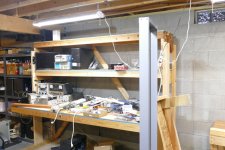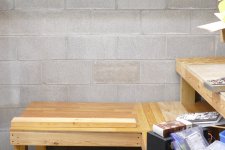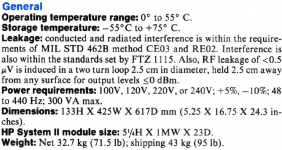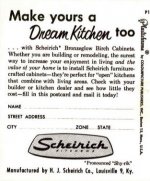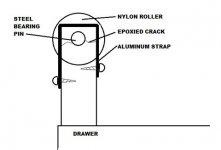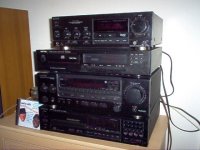I have seen back EMF reaching several kV when driven at resonant frequency of the output xformer in a 50W Marshall top even when connected to the speaker.
I have seen plate voltage spikes of about 2.5KV in a 425 volt guitar amp driven hard into clipping at frequencies near the resonance of the speaker. For most guitar speakers the resonance is in the guitar's frequency range, so this is easy to do.
What did I repair today? My workspace, or part of it. More work tomorrow.
I climbed up on my work bench to reset the Comcast box (the white thing) and noticed a lot of wobble. I built my benches out of 100% recycled material about 7 years ago. The bench was bolted to the equipment rack (the tall grey thing) which was bolted to the other bench, part of which is seen on the lower right. All was stable until I pulled all of the equipment out of the rack to fix the sig gen on the bottom of the stack. With me on top of it I realized that everything could come crashing down real easily and the bench had about 500 pounds of stuff plus me on it.
I removed everything from the bench, dragged it out and added the two diagonal braces that should have been there all along.
During this work I noticed a bit of a problem with the other bench. It will be tomorrows project. Leaving a couple 90 pound HP8642B signal generators on the bench for about a year will do this.
No electronics work will occur until I put everything back where it belongs......assuming I can find it all.
Attachments
I have seen plate voltage spikes of about 2.5KV in a 425 volt guitar amp driven hard into clipping at frequencies near the resonance of the speaker. For most guitar speakers the resonance is in the guitar's frequency range, so this is easy to do.
What did I repair today? My workspace, or part of it. More work tomorrow.
I climbed up on my work bench to reset the Comcast box (the white thing) and noticed a lot of wobble. I built my benches out of 100% recycled material about 7 years ago. The bench was bolted to the equipment rack (the tall grey thing) which was bolted to the other bench, part of which is seen on the lower right. All was stable until I pulled all of the equipment out of the rack to fix the sig gen on the bottom of the stack. With me on top of it I realized that everything could come crashing down real easily and the bench had about 500 pounds of stuff plus me on it.
I removed everything from the bench, dragged it out and added the two diagonal braces that should have been there all along.
During this work I noticed a bit of a problem with the other bench. It will be tomorrows project. Leaving a couple 90 pound HP8642B signal generators on the bench for about a year will do this.
No electronics work will occur until I put everything back where it belongs......assuming I can find it all.
My bench used the heaviest shelf bracket system Menards had for sale, with brackets ever 20". Seems to be pretty solid even with a couple hundred pounds of equipment on it. If it ever starts sagging then I'll rebuild it out of strut.
Is an 8642 really 90 pounds? The ones I have at work have all been in racks or on carts for their whole lives, so I've never actually lifted one.
@Wise:
Plastic rollers are hard to stick with epoxy unless flame or solvent treated.
Keep an eye on it.
You can solvent bond Nylon, I remember someone telling me he used to bind carburetor floats with a water soluble powder in Jetex (it is a factory for those), but the man is not in town most of the time.
You can look that up.
Either make a new roller from rod, if you can.
Or maybe buy another assembly.
Plastic rollers are hard to stick with epoxy unless flame or solvent treated.
Keep an eye on it.
You can solvent bond Nylon, I remember someone telling me he used to bind carburetor floats with a water soluble powder in Jetex (it is a factory for those), but the man is not in town most of the time.
You can look that up.
Either make a new roller from rod, if you can.
Or maybe buy another assembly.
Last edited:
According to HP, 95 lb. shipping weight, 71.5 lb. on the hoof. Close enough for Jazz.Is an 8642 really 90 pounds? The ones I have at work have all been in racks or on carts for their whole lives, so I've never actually lifted one.
Attachments
@Wise:
Plastic rollers are hard to stick with epoxy unless flame or solvent treated.
Keep an eye on it.
You can solvent bond Nylon, I remember someone telling me he used to bind carburetor floats with a water soluble powder in Jetex (it is a factory for those), but the man is not in town most of the time.
You can look that up.
Either make a new roller from rod, if you can.
Or maybe buy another assembly.
Let me clarify...
The nylon roller is fitted into a metal sleeve bearing, which is then fastened into the plastic drawer.
The break was in the plastic tab, which epoxy could weld back together.
And as I mentioned, I added an aluminum strap over the tab/break for re-inforcement, along with two screws.
It's tight and will hold forever now.
Trust me.
I did the same thing to another kitchen drawer 12 years ago, that too is holding up just fine.
Sounds like my kind of day. Especially when you buy your retirement home from somebody who hacked things up.
More proof that if you want something done right- do it yourself.
The kitchen cabinets are nice quality, custom installed in 1971 by Scheirich Kitchens from Lousiville Ky.
I like them, good solid quality wood, mine are English Oak.
Attachments
My kitchen cabinets are original Kayron plastic crap from the early 70's. Cheap particle doors, too.
If they renovated it like they do with new tenants, they said the rent would increase 400$/month.
For that kind of money I can put in a nice Ikea kitchen and pay it off in a year for 400$/month vs paying 400$/month forever for cheap garbage.
It's almost tempting. I think I'll paint it again at least.
If they renovated it like they do with new tenants, they said the rent would increase 400$/month.
For that kind of money I can put in a nice Ikea kitchen and pay it off in a year for 400$/month vs paying 400$/month forever for cheap garbage.
It's almost tempting. I think I'll paint it again at least.
Is an 8642 really 90 pounds? The ones I have at work have all been in racks or on carts for their whole lives, so I've never actually lifted one.
90 pounds was my guestimate. As Mr_Zenith found in the manual the generator itself weighs 71.5 pounds, and packed in its shipping crate it's 95 pounds.
The old 8642's and 8644's have the lowest close in (20 KHz) phase noise of anything HP ever made up until I left Motorola in 2014. I had a stack of 1 X 8642, 2 X 8644 and 1 X 8643 on top of a metal file cabinet at work for IMD measurements at work. That poor cabinet must have been unhappy.
Here is the setup I had in my basement before the recent teardown. It's quite similar to what I had at Motorola. I got a bunch of dead test equipment cheap at hamfests, on Ebay, or at salvage and scrap sales and rebuilt it all. There are 5 working RF signal generators in that rack with an Agilent 4352B PLL analyzer and a computer on top. There is a HP8753C network analyzer and a spectrum analyzer on the bench.
The other end of that bench is where I work on tube amps. The HP6448B power supply alone weighs 60 pounds as it's an old style 1 KW 60 Hz switcher. It was on the second shelf with the network analyzer. The Fluke 407D and Knight KG-664 vacuum tube power supplies aren't light either. There was too much weight up high, and no diagonal bracing. With me up on the bench top it wobbled far too much for comfort.
There is another bench to the right of the rack. It had the pair of 8642B's, an RF power meter, and a HP E4406A transmitter tester. A third 8642B was up there for a while too as the three dead generators became one good one and one semi good one.
I am 7 years older and considerably smaller than when I built the bench. It was a struggle getting those two heavy items down off the second shelf, so I am working on a new layout to keep the heavy stuff where I can get to it with my feet on the floor.
Attachments
@Wise:
The epoxy joint basically held it in place until you did a mechanical joint, making the epoxy superfluous.
Exactly what I would have done, if my time spent on lathe was too much...
But drawer slides are $1 and on here...
The epoxy joint basically held it in place until you did a mechanical joint, making the epoxy superfluous.
Exactly what I would have done, if my time spent on lathe was too much...
But drawer slides are $1 and on here...
I am 7 years older and considerably smaller than when I built the bench. It was a struggle getting those two heavy items down off the second shelf, so I am working on a new layout to keep the heavy stuff where I can get to it with my feet on the floor.
Not to mention wiser. It's good you're taking care of this now while you still can. Not only are you rearranging the stack o' stuff for future access, you're keeping the rack from, er, racking (that's the actual term). While that seems obvious now, sometimes things like that seem to get lost in the interest of expediency - like your move from Florida (don't ask me how I know). Benches made from scrap "two-by" lumber can be immensely strong if proper attention is paid to the joints and bracing. Otherwise things can go south in a hurry once they begin to lean.
Last edited:
@Wise:
The epoxy joint basically held it in place until you did a mechanical joint, making the epoxy superfluous.
Exactly what I would have done, if my time spent on lathe was too much...
But drawer slides are $1 and on here...
Oh, trust me, that epoxy will hold tight, plus it insures that the roller will stay in proper alignment to ride in the metal guide/support track.
This is above the drawer, supporting the rear of the drawer, not the typical "underside" drawer slides that you must think.
Attachments
That looks like a good repair to me. As long as the bearing pin hole isn't wallowed out (and the epoxy probably helps with that), the weak point is the joint between the hanger and the drawer proper. There are probably bumpers or other stops present to prevent any force from being transmitted there.

Not to mention wiser. It's good you're taking care of this now while you still can....
The memory of the bench in Florida might have something to do with it too.
I moved into a new house in 1978. The smallest bedroom was turned into my lab / listening / everything room. I built a bench along one wall from new 2 X 4's and particle board (the 1st mistake). It had a shelf underneath, and a pair of shelves above like this one. I did electronics, mechanicals, and even rebuild an automatic transmission on that bench.
Mistake #2 was turning the 2 X 4's on their side on the shelves to maximize the clearance between the benchtop and shelf. After several years the shelves began to sag, so I simply stuck a vertical 2 X 4 in between the benchtop and the middle shelf, and another between the middle shelf and the top shelf. Problem solved......
Somewhere in the third decade of it's life the particle board had absorbed enough of south Florida humidity to reach it's breaking point. Around 2 AM one night I was awaken by huge kaboom. At first I thought it was a drunk crashing into parked cars near the street (happened twice in 37 years) so I ran outside to see nothing amiss. I looked around the house, and when I opened the door of my workroom I saw the worst possible sight. The 2 X 4 had poked it's way through the benchtop causing both shelves to fail and dump their contents onto the benchtop and the floor. Lots of stuff got broken including a new computer under construction.
Looking back I could have prevented the condo style collapse with one more 2 X 4 from the underside of the bench top to the floor, or extra bracing on the underside of the bench top.
Here the benchtops and shelves are OSB with hardwood flooring samples from a defunct flooring shop on top of the OSB and there is a front to back 2 X 4 underneath every 2 feet.
As with my lab in Florida, nothing on the bench has power after I quit for the night. There is a master kill switch for each bench.
That looks like a good repair to me. As long as the bearing pin hole isn't wallowed out (and the epoxy probably helps with that), the weak point is the joint between the hanger and the drawer proper. There are probably bumpers or other stops present to prevent any force from being transmitted there.
The bearing-pin is solid, a thick steel rivet-like affair into the vertical thing that cracked of 1/4"thick plastic, which is integral to the (molded) plastic drawer.
The bottom face of the roller rides in a steel U-channel just under the countertop.
The bottom of the drawer itself glides on two fixed nylon glides at the face of the cabinet opening.
It's one of those "soft self-closing" types of drawers.
Today's repair was a Philips tabletop CD-Radio system for my neighbor.
The sliding CD door wasn't lifting, and he was using fingers to help it up.
Not a good thing.
The motor drive loading belt was slipping, and since this unit is 17 years old, it was time to blow out the dust and replace the small belt.
Took me an hour..... like new again.
The sliding CD door wasn't lifting, and he was using fingers to help it up.
Not a good thing.
The motor drive loading belt was slipping, and since this unit is 17 years old, it was time to blow out the dust and replace the small belt.
Took me an hour..... like new again.
Attachments
I was thinking of buying this 20-y-0 heavy Kenwood KR-V6060 Amp and DP-1100SG CD off my neighbour. The two at the bottom. £30 each we thought?
Amp was dreck, worst thing I have heard lately. CD had a bent and sticking drawer which I fixed, but nothing special.
Told him to give them to the nearby Charity shop. Amp now on sale there at £50. CD an outrageous £150. Beats me. 😕
Amp was dreck, worst thing I have heard lately. CD had a bent and sticking drawer which I fixed, but nothing special.
Told him to give them to the nearby Charity shop. Amp now on sale there at £50. CD an outrageous £150. Beats me. 😕
Attachments
Headset microphone with a 3 pin mini-xlr. I thought the wire would be a small coax with the shield on the outside. But it seemed to be just a single wire. How does that work?? 
Turned out the wire from the mic was two bunches of enameled wire bundled together. One set red, the other coppery gold. Once split into color groups all was good. That's the first time I've seen that.

Turned out the wire from the mic was two bunches of enameled wire bundled together. One set red, the other coppery gold. Once split into color groups all was good. That's the first time I've seen that.
You were able to solder them was the good part.
I have seen those with metallised polyester as the conductor.
Somehow bonded, not repairable unless you change the wires totally.
But with a retail price of 30 cents, what do you expect from a cell phone hands free?
I have seen those with metallised polyester as the conductor.
Somehow bonded, not repairable unless you change the wires totally.
But with a retail price of 30 cents, what do you expect from a cell phone hands free?
The memory of the bench in Florida might have something to do with it too.
I moved into a new house in 1978. The smallest bedroom was turned into my lab / listening / everything room. I built a bench along one wall from new 2 X 4's and particle board (the 1st mistake). It had a shelf underneath, and a pair of shelves above like this one. I did electronics, mechanicals, and even rebuild an automatic transmission on that bench.
Mistake #2 was turning the 2 X 4's on their side on the shelves to maximize the clearance between the benchtop and shelf. After several years the shelves began to sag, so I simply stuck a vertical 2 X 4 in between the benchtop and the middle shelf, and another between the middle shelf and the top shelf. Problem solved......
Somewhere in the third decade of it's life the particle board had absorbed enough of south Florida humidity to reach it's breaking point. Around 2 AM one night I was awaken by huge kaboom. At first I thought it was a drunk crashing into parked cars near the street (happened twice in 37 years) so I ran outside to see nothing amiss. I looked around the house, and when I opened the door of my workroom I saw the worst possible sight. The 2 X 4 had poked it's way through the benchtop causing both shelves to fail and dump their contents onto the benchtop and the floor. Lots of stuff got broken including a new computer under construction.
Looking back I could have prevented the condo style collapse with one more 2 X 4 from the underside of the bench top to the floor, or extra bracing on the underside of the bench top.
Here the benchtops and shelves are OSB with hardwood flooring samples from a defunct flooring shop on top of the OSB and there is a front to back 2 X 4 underneath every 2 feet.
As with my lab in Florida, nothing on the bench has power after I quit for the night. There is a master kill switch for each bench.
Yikes! That's the stuff of nightmares right there.
I used MDO for my bench top, which seems to be reasonably solid. In hindsight, it's really no better than any other plywood. I put cross pieces under the MDO every 500mm. Vastly overkill, but I built this at a time when 2x4s were still $2.50 each, so it only cost an extra $20 or so to overbuild it.
My mistake? Finishing the top of the bench with a consumer-grade flooring varnish. If I were to do it now, I'd probably use West System in hopes of it lasting a little longer.
- Home
- Member Areas
- The Lounge
- What did you last repair?
